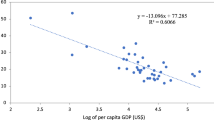Summary
This article deals with three models of complete systems of demand equations (Rotterdam model, AIDS and CBS model). After the models and the theoretical restrictions have been described the parameters are estimated subject to an increasing number of restrictions and using aggregate time series for the Netherlands on five commodity groups.
As the initial results are not altogether satisfactory an attempt is made to improve the estimates by combining the time-series information with cross section data from the Dutch 1974/1975 budget survey. While the revised estimates of the income elasticities are more plausible than the initial ones, the reverse is true for the estimated price elasticities.
Similar content being viewed by others
References
Barnett, W.A., ‘Theoretical Foundations for the Rotterdam Model,’Review of Economic Studies, XLVI (1979), pp. 109–130.
Barten, A.P., ‘Consumer Demand Functions under Conditions of Almost Additive Preferences,’Econometrica, XXXII (1964) pp. 1–38.
Barten, A.P., ‘Maximum Likelihood Estimation of a Complete System of Demand Equations,’European Economic Review,I (1969), pp. 1–73.
CBS,Werknemersbudgetonderzoek 1974/'75, Vol. 2, The Hague, 1979.
CBS,Private Consumption Expenditure and Price Index Numbers for the Netherlands 1951–1977, Statistical Studies, 33, The Hague, 1982.
Deaton, A.S., ‘The Estimation and Testing of Systems of Demand Equations: A Note,’European Economic Review, III (1972), pp. 399–411.
Deaton, A.S., ‘The Analysis of Consumer Demand in the United Kingdom 1900–1970,’Econometrica, XLII (1974), pp. 341–367.
Deaton, A.S., and J. Muellbauer,Economics and Consumer Behavior, Cambridge, 1980a.
Deaton, A.S., and J. Muellbauer, ‘An Almost Ideal Demand System,’American Economic Review, LX (1980b), pp. 312–326.
Driel, J. van, ‘Demand Equations Underlying Consumer Demand Differential Systems,’ internal CBS-report, Voorburg, 1982.
Keller, W.J., and J. van Driel, ‘Differential Consumer Demand Systems,’Kwantitatieve Methoden, VII (1982), pp. 17–44.
Kodde, D.A., ‘Testing the Second-order Condition Implied by the Assumption of Optimization,’ Research Memorandum 8307 of the Institute of Economics, Catholic University of Nijmegen, 1983.
Laitinen, K., Why is Demand Homogeneity so often Rejected?,’Economics Letters, I (1978), pp. 187–191.
Phlips, L.,Applied Consumption Analysis, Amsterdam, 1974.
Theil, H.,Principles of Econometrics, Amsterdam, 1971.
Theil, H.,Theory and Measurement of Consumer Demand, Vol. 1, Amsterdam, 1975.
Yoshihara, K., ‘Demand Functions: An Application to the Japanese Expenditure Pattern,’Econometrica, XXXVII (1969), pp. 257–274.
Zellner, A., ‘An Efficient Method of Estimating Seemingly Unrelated Regressions and Tests for Aggregation Bias,’Journal of the American Statistical Association, LVII (1962), pp. 348–368.
Author information
Authors and Affiliations
Additional information
This paper originated when I was a student of economics at the University of Amsterdam. I am greatly indebted to J.G. Odink who never failed to support and inspire me while I worked on this paper. Also I thank J.S. Cramer, D.A. Kodde and J. van Driel for their comments on an earlier draft, and G. Ridder for his econometric advice. Finally the comments of two anonymous referees are gratefully acknowledged. Of course all remaining errors and omissions are my own.
Rights and permissions
About this article
Cite this article
Van Imhoff, E. Estimation of demand systems using both time series and cross section data. De Economist 132, 419–439 (1984). https://doi.org/10.1007/BF02380341
Issue Date:
DOI: https://doi.org/10.1007/BF02380341




